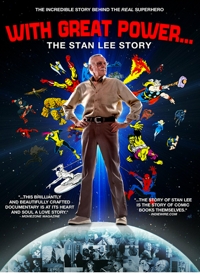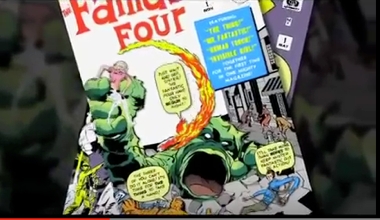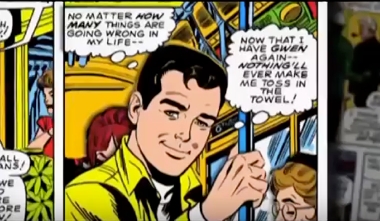 Grade: A-/B+
Grade: A-/B+
Entire family: Yes
2010, 80 min., Color
Documentary
Not rated (would be G)
MPI Home Video
Aspect ratio: 1.37:1
Featured audio: Dolby Digital 2.0
Bonus features: A-/B+ (includes second disc of extras)
Trailer
Amazon link
If your family is like ours, the kids don’t exactly clamor for documentaries. But when the subject of a documentary is Marvel comics legend Stan Lee, and when the documentary employs graphics that remind you of comic books, suddenly there’s interest. Enough for them to watch the whole thing, in fact.
Even years after the hey-day of comic books, when kids could indulge themselves for just 12 or 15 cents, the low-culture genre still holds plenty of fascination. Back then, Lee says, they created a comic per day, and most of the kids I knew purchased at least one per week. It was our pulp fiction. “I learned to read because of Spider-Man comics,” one of the many celebs on this documentary confesses. But a new generation has come to know the Marvel characters mostly through TV and movies—and in this, too, we discover, Lee played a pivotal role.
 Since the age of 19, Lee has been the driving force behind and larger-than-life face of Marvel, a genius who co-created more than 500 distinctive characters over his long career as a story man. Teaming with legendary comic-book artist Jack Kirby and others, he absolutely owned the Sixties, coming up with nine characters who would become major Marvel success stories: Fantastic Four (Nov. 1961), Ant-Man (Jan. 1962), Hulk (May 1962), Thor (Aug. 1962), Spider-Man (Aug. 1962), Iron Man (Mar. 1963), The Avengers (Sept. 1965), Daredevil (April 1964), and Silver Surfer (Oct. 1966). “I just put the words in the people’s mouths and I may have come up with the original idea, but after that it was a partnership,” Lee says.
Since the age of 19, Lee has been the driving force behind and larger-than-life face of Marvel, a genius who co-created more than 500 distinctive characters over his long career as a story man. Teaming with legendary comic-book artist Jack Kirby and others, he absolutely owned the Sixties, coming up with nine characters who would become major Marvel success stories: Fantastic Four (Nov. 1961), Ant-Man (Jan. 1962), Hulk (May 1962), Thor (Aug. 1962), Spider-Man (Aug. 1962), Iron Man (Mar. 1963), The Avengers (Sept. 1965), Daredevil (April 1964), and Silver Surfer (Oct. 1966). “I just put the words in the people’s mouths and I may have come up with the original idea, but after that it was a partnership,” Lee says.
 Like Walt Disney, Lee became a cultural icon himself, and people who never read a comic book in their lives can identify him because of the cameo he makes in every Marvel film adaptation.
Like Walt Disney, Lee became a cultural icon himself, and people who never read a comic book in their lives can identify him because of the cameo he makes in every Marvel film adaptation.
Stan Lee is 94, but he has the energy and enthusiasm of a teenager, still. He’s a life force, and so it makes sense that the directors (Terry Douglas, Nikki Frakes, William Lawrence Hess) would balance Lee’s creative passion with his other great passion: his wife of 70 years, Joan,
who died at age 95 this past July. The footage of the two of them together is as cute (and funny) as can be, and the inclusion doesn’t demystify a legend. Just the opposite, it adds to it. One scene shows  them dancing together for the cameras and Joan quips, “Do you know how lucky we are to move like that at this age? Sweet Jesus!”
them dancing together for the cameras and Joan quips, “Do you know how lucky we are to move like that at this age? Sweet Jesus!”
Success stories always have many “secrets,” stated or implicit, and Lee’s is no exception. Watching this bio you get the feeling that a number of things are responsible:
- He has creative passion and drive—This guy is all energy and ideas. I mean, who starts a company (Stan Lee Media) the year he turns 76? And another one (Pow!) at 86? Watching him is fun all by itself. He can’t talk without performing, he’s so animated, and staffers interviewed say he’s like this all the time.
- He married the right person—Joan clearly matches his passion and feistiness. Lee says, only half-joking, that without Joan he might not have had the motivation to succeed. She provided that, with her spending habits and expensive tastes. Joan was also the one who pushed him to do the kind of adult comic he wanted to do rather than quit without having fulfilled himself. “Everything is mutual,” he jokes. “I love her, and she loves me loving her.”
- He trusted himself and created comics for himself —He paid more attention to the “human” in superhuman and created characters people cared about beyond their powers. His characters lived in the identifiable world and dealt with identifiable problems. He changed comics forever with this new and distinct approach, paving the way for graphic novelists.
- He balanced the need for creative control with the need to credit others—Watching this documentary bio you see how important it is for Lee to have his ideas implemented, because he trusts his judgment. But he also appreciates and respects other talents and is willing to not only collaborate but give credit where credit is due. Sometimes, even more. A funny segment shows a letter he writes for one of his artists saying he gives full co-creator credit to the artist for the development of a character.
- He’s unstoppable and adaptable—Like those old-time battery-operated cars that bumped into something and then backed up and went another direction, he readjusts after every failure and has his pulse on what current fans like. That’s enabled him to pitch getting into Hollywood and the Internet when the money people weren’t able to see the future.
- He has a sense of humor and doesn’t take himself too seriously—This documentary is fun to watch because Lee is fun to watch. He’s hilarious, and the things he comes up with are a combination of practicality, brilliance, and wink-wink gags, like the Merry Marvel Marching Society he came up with as an inclusive insider fan club. That sense of humor plays into his creativity as well. When, in the Sixties, everyone was up in arms over the military-industrial complex, “Just for fun I thought I’d make Iron Man a symbol of the military-industrial complex and I’d make readers like him,” Lee says.
- He goes all out—“Don’t do anything mildly,” is one of his mantras. He’s in for the long haul too. “The word ‘retire’ is a dirty word,” he says. “I’m doing what I want to do . . . I’m having fun. Don’t make me retire.”
- He was in the right place at the right time—When he was only 16, an uncle helped him get a job with Timely Comics at a time when Jack Kirby and Joe Simon were the only two employees; and when those two left three years later over a contract dispute, 19-year-old Lee was named editor and essentially a one-man operation that allowed him to establish himself as a directive and creative force.
- He’s modest—If he were arrogant any hero worship would seem misplaced. Thank goodness he’s not. It enables us to admire him for his vast accomplishments, to like him as a person, and yes, to look to him as a role model. Families with children who aspire to make it in the arts would do well to watch this documentary together. It’s colorful, it’s fun, it’s funny, it’s fascinating, and you learn about U.S. history and pop culture along the way.
 This is a two-disc set that features bonus features on both discs. The first disc has that wonderful click-on art gallery—one for every single character Lee co-created—and a biography on Lee, in addition to 11 different interview outtakes and appearances.
This is a two-disc set that features bonus features on both discs. The first disc has that wonderful click-on art gallery—one for every single character Lee co-created—and a biography on Lee, in addition to 11 different interview outtakes and appearances.
Disc 2 features 40 extended interviews with: Avi Arad, Sean Astin, Dick Ayers, Kenneth Branagh, Nic Cage, Gill Champion, Michael Chillis, Gene Colan, Roger Corman, Tom Desanto, Kirsten Dunst, Mark Evanier, Jon Favreau, Kevin Feige, Lou Ferrigno, James Franco, Thomas Haden-Church, Paris Hilton, Sam Jackson, Jim Lee, Paul Levitz, Tobey Maguire, Todd McFarlane, Jim McLauchin, James Marsden, Frank Miller, Jeremy Piven, Joe Quesada, Seth Rogen w/ Evan Goldberg, John Romita Sr., Joe Simon, Bryan Singer, Joe Sinnott, Kevin Smith, Ringo Starr, Flo Steinberg, Patrick Stewart, Mel Stuart, Roy Thomas, Michael Uslan.
There are over 90 minutes of featurettes, in total, and the production quality is very good, especially for a standard definition DVD. This is the rare documentary that may well get repeat play.
With Great Power: The Stan Lee Story is a great documentary for families!


Leave a comment